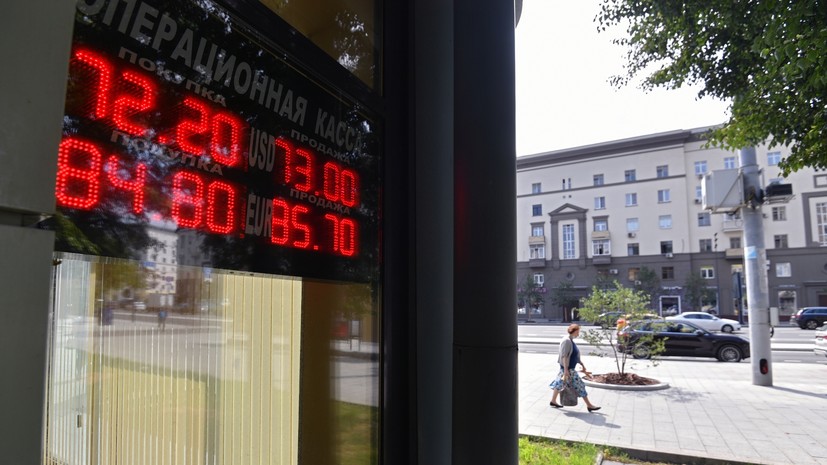On Tuesday, September 1, the opening of trading on the Moscow Exchange was accompanied by the strengthening of the Russian currency.
The dollar rate decreased by 0.6% - to 73.6 rubles, and the euro rate - by 0.3%, to 88.1 rubles.
Note that in August the national currency showed mixed dynamics.
Over the month, the dollar rate fell by 0.45% - to 74 rubles, but at the same time the indicator rose to 76 rubles.
In turn, the euro rate increased by 1% - up to 88.4 rubles.
At the same time, at the auctions on August 26, the value was close to 90 rubles.
This happened for the first time since February 2016.
According to analysts interviewed by RT, in the fall, one of the determining factors for the national currency will be the situation with coronavirus infection.
According to Johns Hopkins University, the number of detected cases of COVID-19 in the world continues to grow and has now exceeded 25.5 million. This situation raises concerns among investors about the prospects for the global economy, so market participants are selling risky assets, including the ruble.
“The mood of the players is influenced by the possibility of a second wave of the pandemic: the spread of the disease again can lead to a decrease in business activity in the world and a longer recovery of the global economy.
Therefore, any signs that the pandemic is not declining cause sales in the markets, and investors are transferring money to protective assets, for example, gold, ”Artyom Deev, head of the analytical department at AMarkets, told RT.
In addition, political instability in Belarus exerts some pressure on the Russian currency.
This point of view was expressed in an interview with RT
chief analyst of TeleTrade Mark Goykhman.
Due to the close economic ties between Moscow and Minsk, investors are afraid of growing tensions in the neighboring country, which negatively affects the position of both the Russian ruble and the Belarusian one.
“The recent rise in the dollar exchange rate to 76 rubles was partly due to the tense situation in Belarus.
This factor will remain important in September, but in many respects it has already been taken into account by investors and can only play a role in the event of additional sharp manifestations, ”explained Mark Goikhman.
Also during the fall, foreign exchange market players will closely monitor the US presidential race and the results of the elections themselves, scheduled for November.
Ilya Zaporozhsky, an expert from the Academy of Finance and Investment Management, spoke about this in a conversation with RT.
"The pre-election race in the United States may affect the dynamics of the ruble, since a possible victory for Biden risks negatively affecting relations between Moscow and Washington," Zaporozhsky said.
At the same time, the rise in oil prices should help the ruble fall, experts say.
In August, Brent crude on the ICE exchange in London has risen in price by more than 6% and is currently trading near $ 46 per barrel.
One of the main drivers of growth in quotations remains the actions of the countries participating in the OPEC + deal.
As a reminder, since May 1, the members of the agreement have resumed their partnership and, in order to combat the global surplus of raw materials, they are reducing oil production.
The actions of the states are aimed at restoring the balance of demand and supply of hydrocarbons in the world market and thereby support the rise in prices after the spring collapse.
From May to July, production of raw materials in the countries participating in the agreement decreased by a total of 9.7 million barrels per day compared to the level of October 2018.
Since August, the states have agreed to somewhat soften the restrictions - up to 7.7 million barrels.
According to the estimates of the US Energy Information Administration (EIA), as a result of the actions of states in the fall, a deficit may appear on the global commodity market.
“If this trend continues in September, then oil will come close to the new psychological mark of $ 50 per barrel.
This can already move the ruble towards a significant strengthening.
I would not be surprised if at the moment of the greatest increase in the price of Brent, the dollar rate drops to 69 rubles, "Valery Yemelyanov, an analyst at Freedom Finance, told RT.
According to experts, some support for the ruble is still provided by the actions of the Bank of Russia.
Recall that in order to stabilize the exchange rate from March 10, the regulator began proactive sale of foreign currency in the domestic market.
Thus, the Central Bank artificially increases the demand for rubles.
In total, during this time, the volume of currency sales amounted to about 1.15 trillion rubles.
At the same time, analysts interviewed by RT assess the possible changes in the ruble dynamics in the fall differently.
According to Artyom Deev, in the near future the dollar exchange rate will fluctuate in the range of 74-77 rubles, and the euro exchange rate - around 87-90 rubles.
In turn, Mark Goikhman does not exclude a decrease in indicators to 71-72 rubles and 85-86 rubles, respectively.

